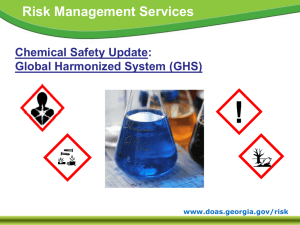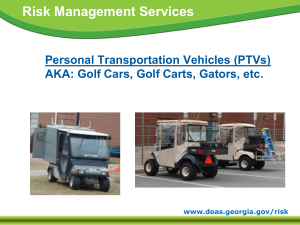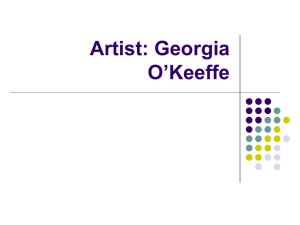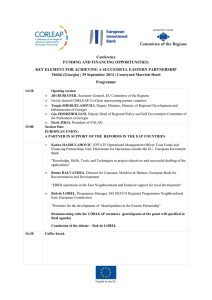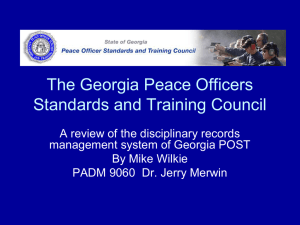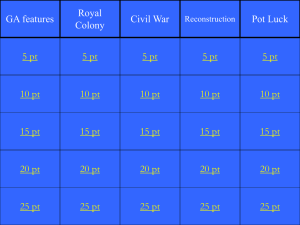Georgia Department of Administrative Services
advertisement
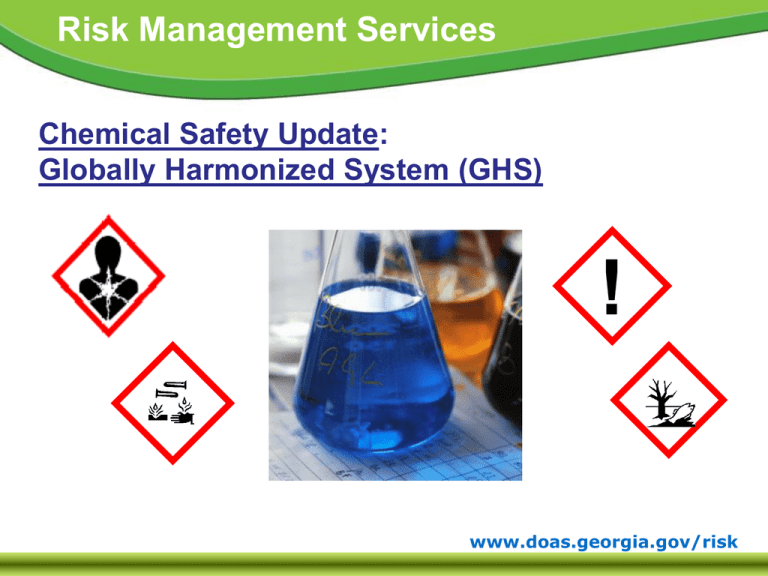
Risk Management Services Chemical Safety Update: Globally Harmonized System (GHS) ! www.doas.georgia.gov/risk Risk Management Services What is the GHS? A common and coherent approach to defining and classifying hazards, and communicating information on labels and safety data sheets. Target audiences include workers, consumers, transport workers, and emergency responders. Provides the underlying infrastructure for establishment of national, comprehensive chemical safety programs. www.doas.georgia.gov/risk Risk Management Services Why is the GHS needed? No country has the ability to identify and specifically regulate every hazardous chemical product. For example, in the United States, there are an estimated 650,000 such products. Adoption of requirements for information to accompany the product helps address protection needs. www.doas.georgia.gov/risk Risk Management Services Georgia Law for State Workers The “Public Employees Hazardous Chemicals Protection and Right to Know Law” was passed in 1988. Georgia 300-3-19 is the governing law. The rules of the law can be found at the GDOL website and the Secretary of State website as well. The purpose of these rules, of course, is to ensure that all Public employees understand their “Right to Know” as it regards to hazardous chemicals in the workplace. www.doas.georgia.gov/risk Risk Management Services State Agency Responsibilities Section 300-19-02 requires Public Employers to ensure that all Public employees are aware of the Act, the regulations, and their responsibilities. Typically this means having a written Hazardous Chemical Communication Program or Hazard Communication Plan. A Hazardous Chemical Protection Communication Coordinator or “Right to Know Coordinator” must be designated within the agency. The “Right to Know Coordinator” will be provided with the proper authority to carry out the duties of the assigned position. www.doas.georgia.gov/risk Risk Management Services Public Employee Hazardous Chemicals Protection and Right to Know Law: Administration of the law (300-3-19.02) Training (300-3-19.03) Contractors’ Responsibilities (300-3-19.04) Employee Grievance/Complaints (300-3-19.05) Exemptions (300-3-19.06) Monitoring of the law (300-3-19.07) www.doas.georgia.gov/risk Risk Management Services Administration (300-3-19.02) The GA Department of Labor (GDOL) Safety Engineering Division shall, as required under the Act, ensure compliance with all training programs required under the law. GDOL must provide written approval of all agency training programs required under the law. GDOL must also provide written approval of the Hazard Communication Plan. www.doas.georgia.gov/risk Risk Management Services Written Program Shall contain how the following will be met: Labeling practices Other forms of warning Safety data sheets Information and training List of chemicals www.doas.georgia.gov/risk Risk Management Services Training (300-3-19.03) Each employee shall be provided with training as required by the Act at the time of initial assignment to a workplace. Re-training must occur at least annually. Department of Labor will verify annual Right to Know training. A written training log must be kept for three years. www.doas.georgia.gov/risk Risk Management Services Definitions “Chemical” Any element, chemical compound or mixture of elements and/or compounds. “Hazardous chemical” Any chemical which is a physical hazard or a health hazard. www.doas.georgia.gov/risk Risk Management Services Definitions “Physical hazard” A chemical for which there is scientifically valid evidence that it is a combustible liquid, a compressed gas, explosive, flammable, organic peroxide, oxidizer, pyrophoric, unstable, reactive or water-reactive. www.doas.georgia.gov/risk Risk Management Services Definitions “Health hazard” A chemical for which there is statistically significant evidence, based on at least one study conducted in accordance with established scientific principles, that acute or chronic health effects may occur in exposed employees. www.doas.georgia.gov/risk Risk Management Services Definitions “Label” means any written, printed or graphic material displayed on or affixed to containers of hazardous chemicals. www.doas.georgia.gov/risk Risk Management Services Labels: Shipping Shipping Container Label (55 gallon/200 liter drum) Effective June 1, 2015 all shipping labels will be required to have all GHS label elements. Pictograms within DOT label DOT Shipping Flammable liquids, toxic, n.o.s. (contains XYZ) UN 1992 www.doas.georgia.gov/risk Transport "Pictograms" Flammable Liquid Flammable Gas Flammable Aerosol Flammable solid Self-Reactive Substances Pyrophorics (Spontaneously Combustible) Self-Heating Substances Substances, which in contact with water, emit flammable gases (Dangerous When Wet) Oxidizing Gases Oxidizing Liquids Oxidizing Solids Explosive Divisions 1.1, 1.2, 1.3 Explosive Division 1.4 Explosive Division 1.5 Explosive Division 1.6 Compressed Gases Acute Toxicity (Poison): Oral, Dermal, Inhalation Corrosive Marine Pollutant Organic Peroxides Risk Management Services Department of Transportation (DOT) Labels DOT labels may take precedence over similar GHS pictograms for shipping containers. DOT does not have labels that correspond to the “Health Hazard” or the “Acute Toxicity” (less severe = exclamation mark). www.doas.georgia.gov/risk Risk Management Services Labels: Pictograms There are 9 pictograms Health Hazards Physical Hazards Environmental Hazards www.doas.georgia.gov/risk Risk Management Services Labels: Pictograms – Health Hazards Acute toxicity (Severe) Acute = short-term effect Acute toxicity (Less Severe): Irritant Dermal sensitizer Acute toxicity (harmful) Narcotic effects Respiratory tract irritation www.doas.georgia.gov/risk Risk Management Services Labels: Pictograms – Health Hazards (cont.) Skin corrosion Serious eye damage/ Eye irritation Carcinogen Respiratory sensitizer Reproductive toxicity Target organ toxicity Mutagenicity Aspiration Hazard www.doas.georgia.gov/risk Risk Management Services Labels: Pictograms – Physical Hazards Explosives Self reactive materials Organic peroxides Flammables Self reactives Pyrophorics Self heating Emits flammable gas Organic peroxides www.doas.georgia.gov/risk Risk Management Services Labels: Pictograms – Physical Hazards (cont.) Corrosive to Metals Oxidizer Gases under Pressure www.doas.georgia.gov/risk Risk Management Services Labels: Signal Words These are words used to indicate the severity of the hazard and alert employees to the potential hazard. Only 2 signal words will appear: “DANGER”(more severe hazard) “WARNING” (less severe hazard) Not all labels will have a signal word. Some chemicals are not hazardous enough to require that a signal word appear on the label. www.doas.georgia.gov/risk Risk Management Services GHS Hazard Communication - Pictograms www.doas.georgia.gov/risk Risk Management Services Exemptions for labeling under OSHA Pesticides (Federal insecticide, fungicide, and rodenticide Act 7 U.S.C. 136) Food, food additive, color additive (FDA 21 U.S.C. 301) Cosmetic, medical or vet device (FDA 21 U.S.C. 301) Distilled spirits (Federal Alcohol Administration Act 21 U.S.C. 201) Consumer products (Consumer Product Safety Act 15 U.S.C. 2501) Agricultural or vegetable seed (Federal Seed Act 7 U.S.C. 1551) www.doas.georgia.gov/risk Risk Management Services Definitions “Safety Data Sheet” Written or printed material concerning a hazardous chemical which is prepared in accordance with the standard. www.doas.georgia.gov/risk Risk Management Services Safety Data Sheets (SDS) SDS access for employees Readily accessible, and During work shift Electronic and other alternatives are acceptable No barriers to immediate employee access When employees travel May be kept at primary workplace www.doas.georgia.gov/risk Risk Management Services SDS Format: 1. 2. 3. 4. 5. 6. 7. 8. 16 headings Identification Hazard(s) identification Composition/information on ingredients First-aid measures Fire-fighting measures Accidental release measures Handling and storage Exposure control/personal protection www.doas.georgia.gov/risk Risk Management Services SDS Format: 16 headings (cont.) 9. 10. 11. 12. 13. 14. 15. 16. Physical and chemical properties Stability and reactivity Toxicological information Ecological information Disposal considerations Transport information Regulatory information Other information www.doas.georgia.gov/risk Risk Management Services Contractors (300-3-19.04) It is the responsibility of independent contractors working on State property to ensure its contract employees are provided information and trained on hazardous chemicals. Workplace Managers shall be notified at least (30) thirty days prior to any hazardous chemical work at a State site by an independent contractor. www.doas.georgia.gov/risk Risk Management Services Employee Grievance/Complaint (300-3-19.05) Any grievance/complaint filed by a Public employee alleging that the employee has been adversely affected by a violation of the Act, must first be processed through the employer’s established grievance/complaint procedure. www.doas.georgia.gov/risk Risk Management Services Exemptions (300-3-19.06) Students enrolled in educational institutions are not required to receive hazardous chemical training, unless employed by the institution either full or part-time. The law does not cover local, city, school systems or private colleges or the employees of these institutions including county governments. Publicly available cleaning and household products and supplies and latex paints used in the same manner in which a consumer would use them and on an irregular basis are not covered by these regulations. Personnel engaged in routine cleaning and painting operations are covered. www.doas.georgia.gov/risk Risk Management Services Monitoring (300-3-19.07) The Safety Engineering Division of the Georgia Department of Labor will monitor public employer compliance with the Act. www.doas.georgia.gov/risk Risk Management Services State Agency Reporting Requirements File the Name of your agency’s Right to Know Coordinator with the GDOL Safety Engineering Division. Submit your Written Hazardous Communication Plan for approval with the GDOL Safety Engineering Communication Plan. File with the GDOL Safety Engineering a List of Hazardous Chemicals used at your agency by January 1st and July 1st of each year. Provide a log of employees’ hazardous chemical training conducted annually to the GDOL. www.doas.georgia.gov/risk Risk Management Services Questions? This PowerPoint is meant to supplement an existing Chemical Safety Training Program. Another great source of information is the BOR EHS website: http://www.usg.edu/ehs/training/rtkbasic/. More information is available on the OSHA website. Contact Information Hiram S. Lagroon, BS Chief Loss Control & Safety Officer (404) 463-6309 Hiram.Lagroon@doas.ga.gov Charles G. Lawrence, III, CSP, REM, ARM-P Chief Loss Control & Safety Officer (404) 657-4457 Charles.Lawrence@doas.ga.gov www.doas.georgia.gov/risk
